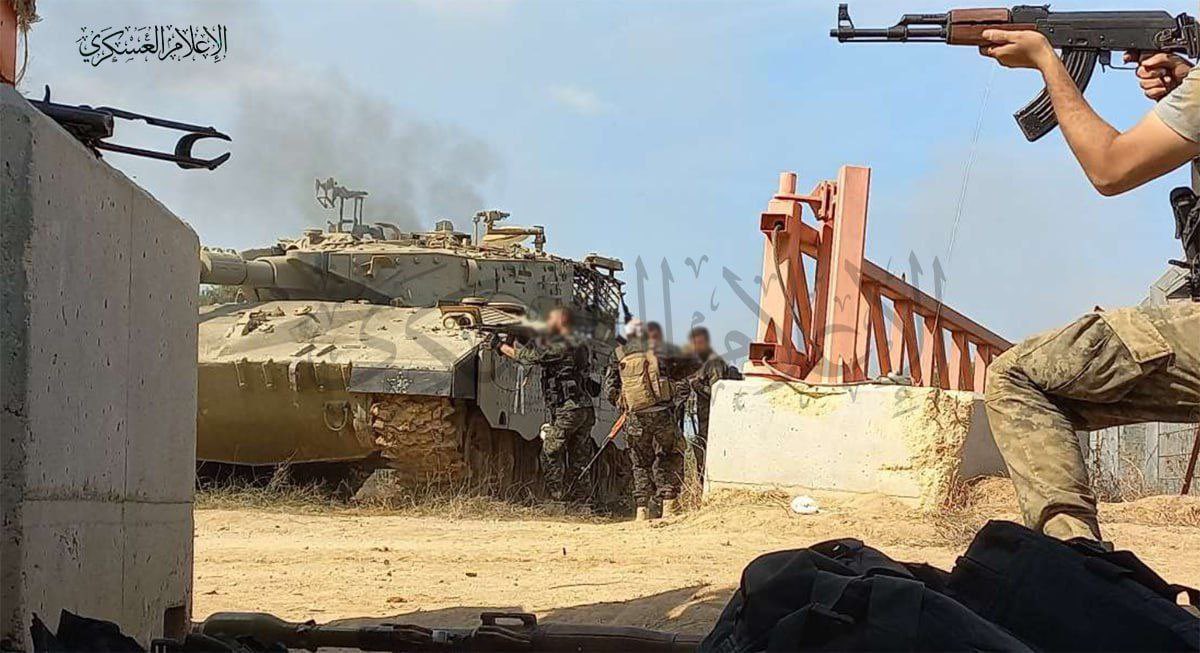Israeli Merkava battle tanks have been spotted with metal cage roofs over their turret hatches at deployment points around Gaza, similar to how Russian tanks sported the same during their “Special Military Operations” (SMO) in Ukraine.
The roofs are expected to protect the tanks from explosives and grenades dropped by drones that are usually aimed at falling inside the hatches or near the origin of the main gun.
A Merkava-4 was destroyed this way by Hamas on October 7 during the group’s surprise multi-front strike. Footage from a UAV showed the tank exploding and being destroyed in secondary explosions.
The tank deployments suggest an Israeli ground offensive into Gaza is taking shape after much speculation. A land invasion had been assessed to be politically and militarily costly for Tel Aviv, given Hamas anticipating the action as a part of the Netanyahu government’s severe backlash and preparing for punitive and extremely severe air raids.
Not only is the IDF likely to sustain losses, but it also invites direct Arab diplomatic intervention, Iranian military support, and determined Hezbollah action from the north, expanding the war into a full-blown regional conflict. But, it is Israel’s only option if is to achieve its goal of completely “destroying” Hamas.
Israeli Tanks Adopt Cope Cages
Pictures released by Getty Images showed a large armored group with Merkava-4 tanks, ‘Namer’ Tracked Infantry Fighting Vehicles (IFV), and tank recovery vehicles at a staging zone. Six Merkava-4s can be seen with the metal cages above the turret hatch, with the cages themselves supported by thin metal rods from the turret.
Several other pictures on social media from both Israel-friendly accounts and critics showed individual and sections of Merkava tanks with the ‘cope cages’ or ’emotional support’ cages — a pejorative term used for similar ad-hoc enhancements on Russian tanks earlier in the war.
‘Can’t Stop Drone-Dropped Rockets’
Online commentators have pointed out that Hamas employs PG-7VR rocket-propelled grenade (RPG) rounds dropped from UAVs. These Russian-origin rounds are dedicated High Explosive Anti-Tank (HEAT) rockets to counter Explosive Reactive Armor (ERA).
ERA involves square or rectangular-shaped explosive-filled panels covering the tank’s turret and weak parts of the chassis. This causes the warhead of a rocket or a gun round to explode prematurely before hitting the tank’s main steel body.
But the PG-7VR uses a ‘tandem warhead’ design, where the rocket is longer with a primary smaller charge, with a more significant explosive charge behind it. The small warhead hits the ERA panel, disabling it and clearing the way for the main anti-tank warhead to hit the armor.
Thus, the post by X (formerly Twitter) handle, Iran Defense, suggests that the PG-7VR should work precisely the same way even when dropped vertically from Hamas drones. Hamas also has a large inventory of regular ATGMs, but Merkava’s Trophy Active-Protection System (APS) can be expected to tackle those.
Hamas also has other ATGMs, like the Russian-made Konkurs, Korner, and the North Korean Bulsae-2. But none of these have the ‘top-attack’ mode, where the missile climbs up after leaving the launcher and dives down onto the tank, hitting the top of the turret – the weakest part.
Israeli Merkava Mark lV Main Battle Tanks at Staging Points near the Gaza Strip have now been seen Equipped with Top Slat Armor also known as “Cope Cages” which have become Extremely Popular because of the War in Ukraine and their use on Russian and Ukrainian Tanks; the Armor is… pic.twitter.com/JbfeXE0vBB
— OSINTdefender (@sentdefender) October 16, 2023
Hamas Preparing For Israeli Ground Invasion
Hamas has circulated a pamphlet guidebook for its fighters that recommends countering the Alox and the Trophy APSs by firing multiple RPG rounds from 45 meters to overwhelm them; whether these would be successful remains to be seen when the IDF begins its ground operation.
It can be said that both parties have been preparing for this kind of war, with Hamas developing its dense network of underground tunnels assuming to operate indiscriminately hostile skies in an urban environment. The IDF, too, is designed to fight a resistance non-state actor in the latter’s home front.
However, the defending Hamas essentially holds the advantage, enjoying the privilege of exploiting the destroyed city’s tunnels and remaining hidden in a subterranean network that only they know.
The IDF’s advanced technology, too, will not be a game-changer. This is evident from the destruction of the Merkava-4 from the drone-dropped bomb, the overwhelming Iron Dome air defense system, and the general shock and surprise it sprang on the morning of October 7 that left the Israeli intelligence and security establishment completely aghast.

Russia’s Ridiculed Cope Cages
Supposedly installed with the hope of preventing US-made Javelin anti-tank guided missile (ATGM) from hitting the tank’s top section so it explodes upon coming into contact with the cage itself, the hack didn’t always produce results and ended up destroying several dozen Russian tanks in the first two months of the war.
The cages, therefore, represented a futile attempt before the guaranteed devastation from the Javelin, serving at best to assuage Russian tank crewmen of some protection psychologically.
But surprisingly, as EurAsian Times reported in subsequent articles, the practice became widespread and was even adopted by Ukrainian tanks and Self-Propelled Guns (SPG), suggesting a certain degree of success. This was against Russian loitering munitions like the Lancet-3, which exacted a heavy toll on US and NATO-origin artillery and tanks.
- The author can be reached at satamp@gmail.com
- Follow EurAsian Times on Google News